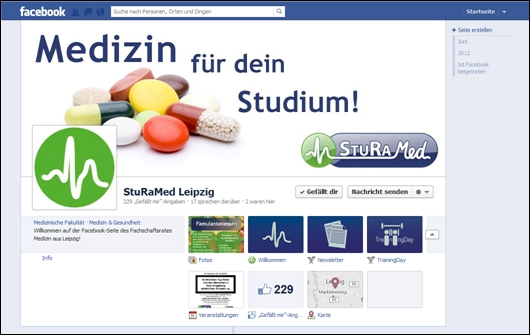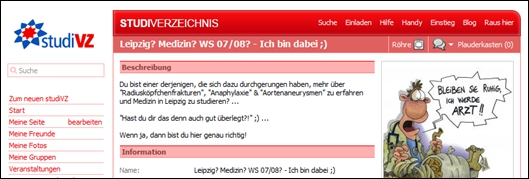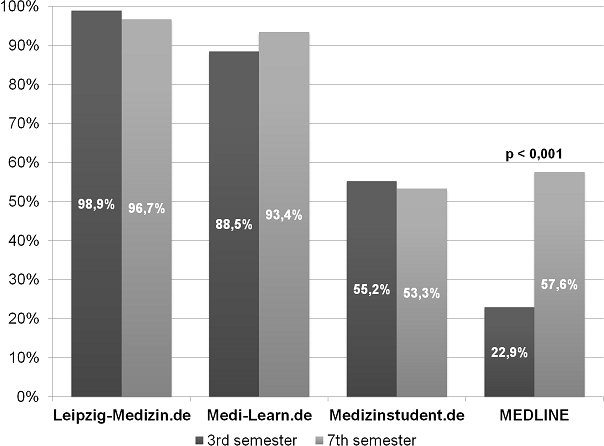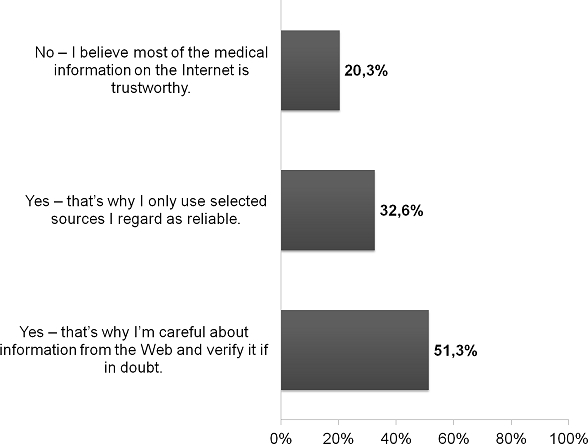[Study of medicine 2.0 due to Web 2.0?! - Risks and opportunities for the curriculum in Leipzig]
Gunther Hempel 1Martin Neef 2
Daisy Rotzoll 3
Wolfgang Heinke 1
1 Universitätsklinikum Leipzig AöR, Klinik und Poliklinik für Anästhesiologie und Intensivtherapie, Leipzig, Deutschland
2 Universitätsklinikum Leipzig AöR, Abteilung für Kardiologie und Angiologie, Leipzig, Deutschland
3 Universität Leipzig, Medizinische Fakultät, LernKlinik Leipzig, Leipzig, Deutschland
Abstract
Web 2.0 is changing the study of medicine by opening up totally new ways of learning and teaching in an ongoing process. Global social networking services like Facebook, YouTube, Flickr, Google Drive and Xing already play an important part in communication both among students and between students and teaching staff. Moreover, local portals (such as the platform [
The many possibilities and rapid changes brought about by social networks need to be publicized within medical faculties. Therefore, an E-learning and New Media Working Group was set up at the Faculty of Medicine of Universität Leipzig in order to harness the opportunities of Web 2.0, analyse the resulting processes of change in the study of medicine, and curb the risks of the Internet.
With Web 2.0 and the social web already influencing the study of medicine, the opportunities of the Internet now need to be utilized to improve the teaching of medicine.
Keywords
medical education, medical students, social media, Germany
Introduction
Fifteen years ago, medical students used to look up technical terms in encyclopaedias, nowadays, they turn straight to websites such as Wikipedia. Standard textbooks which for decades were the constant companion of every future doctor have now been replaced by electronic versions, for instance smartphone apps. And whereas ten years ago students used to phone each other to organize study groups, these days this is normally done using the invitation functions of various social networks like Facebook. Even the obligatory discussion of past papers before every examination is now increasingly taking place in local Internet forums or by using online office programs like Google Drive. A student survey at the Faculty of Medicine in Leipzig found that on average, the Internet is used for study purposes alone for 8.3 hours every week by the some 200 respondents in the third and seventh semesters who took part [1]. As in many other walks of life, times have changed, and even the study of medicine has been altered by technical progress [2], [3]. However, the extent to which teaching staff have caught up with the changes and how they will be table to take students’ altered learning behaviour into account in the future are currently uncertain.
Definitions
Before the benefits of Web 2.0 can be debated, we first need to establish what the term Web 2.0 actually means. Although it first cropped up in 2004 at various developers’ conferences in the USA, it has still not yet been clearly defined. Sir Timothy Berners-Lee, who is regarded as the inventor of the World Wide Web, stated the following in an interview he gave in 2006: “I think Web 2.0 is of course a piece of jargon, nobody even knows what it means.” [
In the authors’ opinion, the term Web 2.0 can now be defined more clearly. Web 2.0 marks a clear advance on ‘Web 1.0’ – a concept not actually defined as such – in which just a few providers made information available to users for passive consumption. In Web 2.0, the Internet user is no longer primarily a consumer but is increasingly playing an active role. Supported by interactive applications, users create, edit and distribute content largely by themselves. The various Web 2.0 platforms enable any user to share information without the need for advanced programming skills. As a result, projects can be developed whose value increases as more and more users take part (e.g. Wikipedia). Web 2.0 applications are ultimately nothing but platforms made available by a single operator whose content is, however, written and updated by contributors.
In the meantime, the term Web 2.0 is being gradually replaced by the terms ‘social web’ and ‘social media’, which refer to all the media employed by users to interact with each other. Emphasis is placed on communication and sharing user-generated content [
The use of different platforms by Leipzig students of medicine
Below, online portals which are used by students of medicine at Universität Leipzig are described. Both current and possible future uses in connection with the study of medicine are discussed (see attachment 1 [Att. 1]).
Wikipedia
Wikipedia [
Teaching staff have relatively little influence on the use of Wikipedia. Although they can of course actively take part in writing content, there are no figures recording how many lecturers actually do so. One main criticism levelled at Wikipedia (and which has already been researched on several occasions) is the lack of references and the errors contained in some medical articles. This is the downside of one of the big advantages of Web 2.0 – the possibility for any user to actively change content, regardless of their knowledge. With not every article being reviewed by experts, errors can slip through, causing problems in not just medicine but also potentially any other field [5].
YouTube
YouTube [
Recent studies have shown that being able to watch these streamed film clips from any web-enabled device at any time is very popular with students, and is also more advantageous than conventional methods such as handing out DVDs [6]. In addition to the videos themselves, YouTube’s comments feature can be for small discussions. This aspect can be expanded by integrating the YouTube player into a separate portal; a forum/upload feature can be used to allow a more detailed debate about the embedded video. Integration of this nature is for example planned for the student portal in Leipzig. Moreover, this is something which could also be employed outside a study environment. For instance, many hospitals have already begun to post information films for patients online. And at the Faculty of Medicine at Universität Leipzig, video posts are augmented by educational videos for the general public dealing with, say, relevant aspects of first aid (stable lateral position, cardiopulmonary resuscitation, etc). Then again, studies have shown that the quality of such instructional videos often varies enormously, and that those viewed the most often are not necessarily the best ones in terms of their medical content [7].
Apart from YouTube itself, there are now a number of other video sharing sites with different target groups. One example is Vimeo [
Social networks
Similar to YouTube, many hospitals and medical schools have been increasingly present in social networks in recent years. At the top of the pile is Facebook, which, according to recent studies, is used these days especially frequently by healthcare institutions in the UK [8].
1. Facebook
Facebook is by far the biggest social network with more than 900 million active users worldwide [

The experience of the student council shows that by taking this new approach, it is now possible to notify more students in less time than used to be the case via the regular website. In recent months, the university’s use of Facebook has also grown. Universität Leipzig now has its own official Facebook page [
Social networks like Facebook can also be significant for postgraduates. Groups of specialists have begun using social networks to interest medical students in certain fields of medicine. This is done by means of for instance local campaigns, congresses announced on Facebook, and small competitions for which entrants have to subscribe to the Facebook page concerned. One example is ‘My pulse’ – a campaign by the German Association of Anaesthesiologists [
2. StudiVZ/MeinVZ
StudiVZ [
StudiVZ/MeinVZ also allow separate fan pages to be started. Furthermore, they enable private or public groups to be set up – a feature which was frequently used by Leipzig students during the network’s heyday (see Figure 2 [Fig. 2]).

Since then, however, its significance has declined sharply. The networks have been clearly overtaken by Facebook regarding both the numbers of users and visit duration. This highlights one of the risks of such projects in Web 2.0 – for despite becoming so successful so quickly, they can disappear just as rapidly. This is an aspect which must be borne in mind when planning integration into the curriculum. Since students’ user behaviour can only be influenced by lecturers to a very limited extent, sometimes well thought-out Web 2.0 educational projects which have been meticulously planned may come to nothing simply because not enough students actively use the relevant platform. Because StudiVZ and its related networks are now only used rarely by students, they play a far smaller role in medical training. Accordingly, there are currently no projects afoot at Leipzig to integrate StudiVZ/MeinVZ into the curriculum.
3. XING
XING [

Apart from the Alumni Newsletter with information on current university life, XING is used to notify ex-students of reunions and other events at Universität Leipzig.
Internet forums/communities
Another prototype and one of the earliest representatives of Web 2.0 was Internet forums. Following registration (generally free) and the creation of an account, anyone can discuss specific issues with other interested users in a variety of forums and make their own contributions to fuel the debate. Such online forums are widespread among medical students. The two main ones in Germany are Medi-Learn.de and DocCheck Campus (previously Medizinstudent.de), both of which evolved from a forum into successful businesses. Apart from a simple forum, many other useful things for medical students are to be found there such as oral examination records and a database of scripts for the various phases of medical degree courses. These two large providers are joined by a large number of smaller local projects, which are often run by student organizations or individual enthusiastic students. Studies at the Faculty of Medicine of Universität Leipzig have shown that local projects among medical students are usually the best known and also the most used by far. And when students start studying, they are far better known that the common medical search portals such as MEDLINE (see Figure 4 [Fig. 4]).

Leipzig-Medizin.de
Since 2003, the local platform Leipzig-Medizin.de [

In addition to current problems, past examination questions are discussed and tackled, particularly in the revision period. With each individual student benefiting from others’ knowledge, in a short time almost all outstanding questions can be jointly solved. For teaching staff, a platform like this enables them to contact students directly. This possibility is used by lecturers both overtly (i.e. they say they are faculty members) and ‘covertly’. Lecturers can see from the discussions where the problems lie and what aspects should in future be taught differently. By the way, all the content of Leipzig-Medizin.de is available to teaching staff, too, once they have registered. As a result, more and more lecturers have joined the portal in recent years so that they can benefit as well.
Google Drive
In addition to the examples of Web 2.0 discussed, there is a whole raft of other well-known and less well-known portals and applications. One platform which is fundamentally different from the others is Google Drive [
Problems and opportunities for the curriculum
Apart from its many benefits, Web 2.0 also contains a number of risks that many users aren’t initially aware of. These include the validity of data freely available on the Web, the commercial interests of some listed companies, the potential leak of sensitive data (such as student data, patient data) and the volatility of the Internet (as epitomized by the face of StudiVZ). As studies have found that many university lecturers are unaware of both the risks and the possibilities of Web 2.0 or do not know how to use the various portals [12], they need to undergo regular training. This is done annually in Leipzig during university teacher training. However, it is apparent that the need for training on how to work effectively yet safely with Web 2.0 will grow.
One worry for university teachers considering the use of Web 2.0 in medical training concerns the validity of the information found in various online sources. Different studies (e.g. by Wikipedia) have failed to provide a uniform picture. However, a survey conducted among students in the Faculty of Medicine at Universität Leipzig revealed that students are well aware of this problem and only a small proportion of users trust the information they find unquestioningly (see Figure 6 [Fig. 6]).

Another important aspect is that most social networks pursue commercial objectives. Although this may not be apparent at first glance, large companies are responsible for all platforms, and their primary aim is to maximize their profits. This may prompt decisions that are not in their users’ best interests. Therefore, commercial platforms should not be used without reservation in curricular teaching. Once again, appropriate training for lecturers would make sense. The issue of data ownership has not been clarified when non-university networks are used. Each medical faculty manages huge quantities of confidential student data (e.g. their enrolment number, dates of birth and home addresses). Within each faculty, it is possible to influence the degree of data protection and data backup. However, this is no longer the case regarding social networks. When faculties forward sensitive data to social networks (and hence to the companies behind them), what happens to this data is beyond their control. This is one of the main reasons why social networks have not yet found their way into curricular teaching and are only used in optional courses, where students can decide themselves what information to provide. Although this approach is not without its problems, at least no students are forced to register with a social network against their will during their compulsory training.
One problem which is set to become even more significant in the future is the protection of patient data. The possibilities offered by Web 2.0 in conjunction with mobile technology such as smartphones raise the risk of sensitive patient data being leaked. In future, students and staff at healthcare facilities must at all costs be alerted to the dangers [13], [14]. At present, for example, very few medical schools in the United States have suitable guidelines in place governing behaviour in the social web [15].
The volatility of the World Wide Web could also prove to be problematic. Something which on the one hand is an advantage could also be a disadvantage if, say, sizeable teaching projects or even entire curricula were geared to certain Web 2.0 applications – and hence dependent on them. If the application in question is closed down (e.g. for commercial reasons as mentioned above) or students stop using it (as was the case with StudiVZ), a painstakingly compiled project will have to be abandoned. The answer could be for institutions to create their own portals which integrate various external Web 2.0 applications and possibilities and are adapted to local conditions. Platforms tailored to the interests of the medical faculties behind them would enable the creation of concepts which enjoy long-term success without having to be dependent on external providers. In-house portals also have the advantage that students are not forced to register with external providers like Facebook in connection with their studies. Teaching staff need to accept the fact that there are still students who refuse to join social networks on principle for privacy reasons.
Open-source systems like Moodle
For these reasons, the Faculty of Medicine at Universität Leipzig is currently extensively expanding the existing student portal to include various Web 2.0 services in an effort to improve not just teaching but also interaction among students and with teaching staff. The aim is to harness the benefits of Web 2.0 in order to advance curricular teaching.
So far, social networks have only influenced curricular teaching ‘off the record’. Communication among students about courses in the platform Leipzig Medizin.de acts as a form of feedback for lecturers which bypasses the official evaluation carried out by the Faculty of Medicine but still reaches interested teaching staff directly and hence affects the development of courses and exams. Two direct examples are the fact that past questions circulating on the platform aren’t reused in multiple choice exams while oral examiners find out what questions students are expecting from them.
An online survey is going to be carried out into the needs and requests of medical students and teaching staff in Leipzig with respect to the integration of Web 2.0 components so that the benefits can be fully tapped by them. Run by the E-Learning and New Media Working Group at the Faculty of Medicine, the project will also evaluate how these target groups use Web 2.0 depending on various parameters (semester/job, age, gender, online access, etc). Working on the basis of a few smaller surveys already completed at the Faculty of Medicine, this study is intended to lay the basis for all future projects in the field of Web 2.0 and e-learning. This is the only way to correctly integrate the corresponding Web 2.0 components into the existing student portal and to maximize the benefits for students and teachers.
Web 2.0 and the social web have already considerably influenced life in recent years. Looking to the future, the opportunities that have arisen now need to be incorporated into the teaching of medicine.
Competing interests
The authors declare that they have no competing interests.
References
[1] Girbardt C. Der Einsatz von E-Learning durch Studierende der Medizin: Eine Untersuchung an der Universität Leipzig, Dissertation. Leipzig: Universität Leipzig; 2012.[2] McLean R, Richards BH, Wardman JI. The effect of Web 2.0 on the future of medical practice and education: Darwikinian evolution or folksonomic revolution? Med J Aust. 2007;187(3):174–177.
[3] Giustini D. How Web 2.0 is changing medicine. BMJ. 2006;333(7582):1283–1284. DOI: 10.1136/bmj.39062.555405.80
[4] Hughes B, Joshi I, Lemonde H, Wareham J. Junior physician's use of Web 2.0 for information seeking and medical education: a qualitative study. Int J Med Inform. 2009;78(10):645–655. DOI: 10.1016/j.ijmedinf.2009.04.008
[5] Pender MP, Lasserre KE, Del Mar C, Kruesi L, Anuradha S. Is Wikipedia unsuitable as a clinical information resource for medical students? Med Teach. 2009;31(12):1095–1096.
[6] George DR, Dellasega C. Use of social media in graduate-level medical humanities education: two pilot studies from Penn State College of Medicine. Med Teach. 2011;33(8):e429-e434. DOI: 10.3109/0142159X.2011.586749
[7] Murugiah K, Vallakati A, Rajput K, Sood A, Challa NR. YouTube as a source of information on cardiopulmonary resuscitation. Resuscitation 2011;82(3):332–324. DOI: 10.1016/j.resuscitation.2010.11.015
[8] van de Belt TH, Berben SA, Samsom M, Engelen LJ, Schoonhoven L. Use of social media by Western European hospitals: longitudinal study. J Med Internet Res. 2012;14(3):e61. DOI: 10.2196/jmir.1992
[9] Muhlen M von, Ohno-Machado L. Reviewing social media use by clinicians. J Am Med Inform Assoc. 2012;19(5):577-781. DOI: 10.1136/amiajnl-2012-000990
[10] Phadtare A, Bahmani A, Shah A, Pietrobon R. Scientific writing: a randomized controlled trial comparing standard and on-line instruction. BMC Med Educ. 2009;9:27. DOI: 10.1186/1472-6920-9-27
[11] George DR. Using Google Docs to enhance medical student reflection. Med Educ. 2012;46(5):504–505. DOI: 10.1111/j.1365-2923.2012.04233.x
[12] Sandars J, Schroter S. Web 2.0 technologies for undergraduate and postgraduate medical education: an online survey. Postgrad Med. J 2007;83(986):759–762. DOI: 10.1136/pgmj.2007.063123
[13] Whipple EC, Allgood KL, Larue EM. Third-year medical students' knowledge of privacy and security issues concerning mobile devices. Med Teach. 2012;34(8):e532-e548. DOI: 10.3109/0142159X.2012.670319
[14] Osman A, Wardle A. Is it time for medicine to update its Facebook status? BMJ. 2011;343:d6334. DOI: 10.1136/bmj.d6334
[15] Kind T, Genrich G, Sodhi A, Chretien KC. Social media policies at US medical schools. Med Educ Online. 2010;15. DOI: 10.3402/meo.v15i0.5324
Attachments
| Attachment 1 | Table 1: Overview of the advantages and disadvantages of various Web 2.0 applications and their integration in the Leipziger Curriculum (Attachment.pdf, application/pdf, 38.83 KBytes) |




